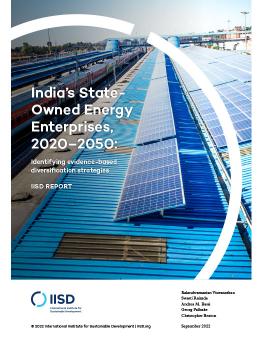
India's State-Owned Energy Enterprises, 2020-2050
Identifying evidence-based diversification strategies
India has positioned itself as a strong advocate of climate action among emerging economies, aiming to significantly scale up renewable energy by 2030 and to reach net-zero emissions by 2070. The country’s energy state-owned enterprises, known as public sector undertakings (PSUs), will have a key role to play as India gears up to become net-zero by 2070—yet, many of them remain heavily dependent on coal. This study provides an evidence-based approach to identify diversification strategies that will prepare these firms for the future while continuing to bring revenues to the government, creating jobs, and supporting local communities.
-
Three of India’s biggest central state-owned enterprises—Coal India Limited (CIL), NTPC, and Indian Railways—can help the country reach its climate goals while seizing a share of the clean energy market and mitigating an estimated 22%–28% cash flow gap by 2050.
-
Our evidence-based approach shows how state-owned companies can be part of India’s clean energy future while bringing revenues to the government, creating jobs, and supporting local communities.
-
Seven out of 10 largest state-owned firms in India are from the energy sector. They will play a key role in helping India become net-zero while diversifying their businesses and avoiding potential revenue gaps.
This study uses PSUs in the coal sector to show how energy businesses can identify their future uncertainties while also finding opportunities in the changing energy system. Taking a few concrete measures in the next few years to diversify their businesses can allow these firms—and other similar PSUs in India—to alleviate future uncertainty and avoid potential revenue gaps.
The companies can follow these six steps to ensure they are part of India’s clean energy future:
- Create a net-zero roadmap with interim targets, which can become a guide for future decisions.
- Develop in-house estimates on transition business risks.
- Identify new clean energy business opportunities and become early adopters of clean energy technologies.
- Set clean energy targets in proportion to anticipated change and periodically increase the ambition of these targets.
- Build strategic partnerships with other PSUs to share expertise and invest in research and development to build internal capacity in new and emerging clean energy technologies.
- Make ambitions for the transition public to send positive market signals.
The report encourages all state-owned energy enterprises to use an evidence-based approach to produce their own detailed internal assessments and a strategy for transition into a clean energy business.
You might also be interested in
India Faces Clean Energy Challenges as Energy Demand Soars and Global Fossil Fuel Subsidies Rise
New research finds the global energy crisis and increasing energy demand have pushed India's energy subsidies to a 9-year high.
Implementing Solar Irrigation Sustainably
This guidebook provides recommendations to state policy-makers on how they can implement solar irrigation models, particularly decentralized solar plants for irrigation under the PM-KUSUM scheme, effectively and sustainably.
Agrivoltaics In India : Simultaneous Use Of Land For Both Agriculture And RE Power Generation Offers A Potential Solution
Agrivoltaics — the simultaneous use of land for both agriculture and photovoltaic (PV) power generation — offers a potential solution to the competition for land resources between agriculture and renewable energy that may arise in the future in India.
Unlocking Supply Chains for Localizing Electric Vehicle Battery Production in India
This study aims to highlight the key supply chain barriers in localizing electric vehicle (EV) battery cell manufacturing in India. It summarizes consultations with 12 companies, as well as experts and policy-makers, to determine the crucial challenges and opportunities in localizing battery manufacturing in India.